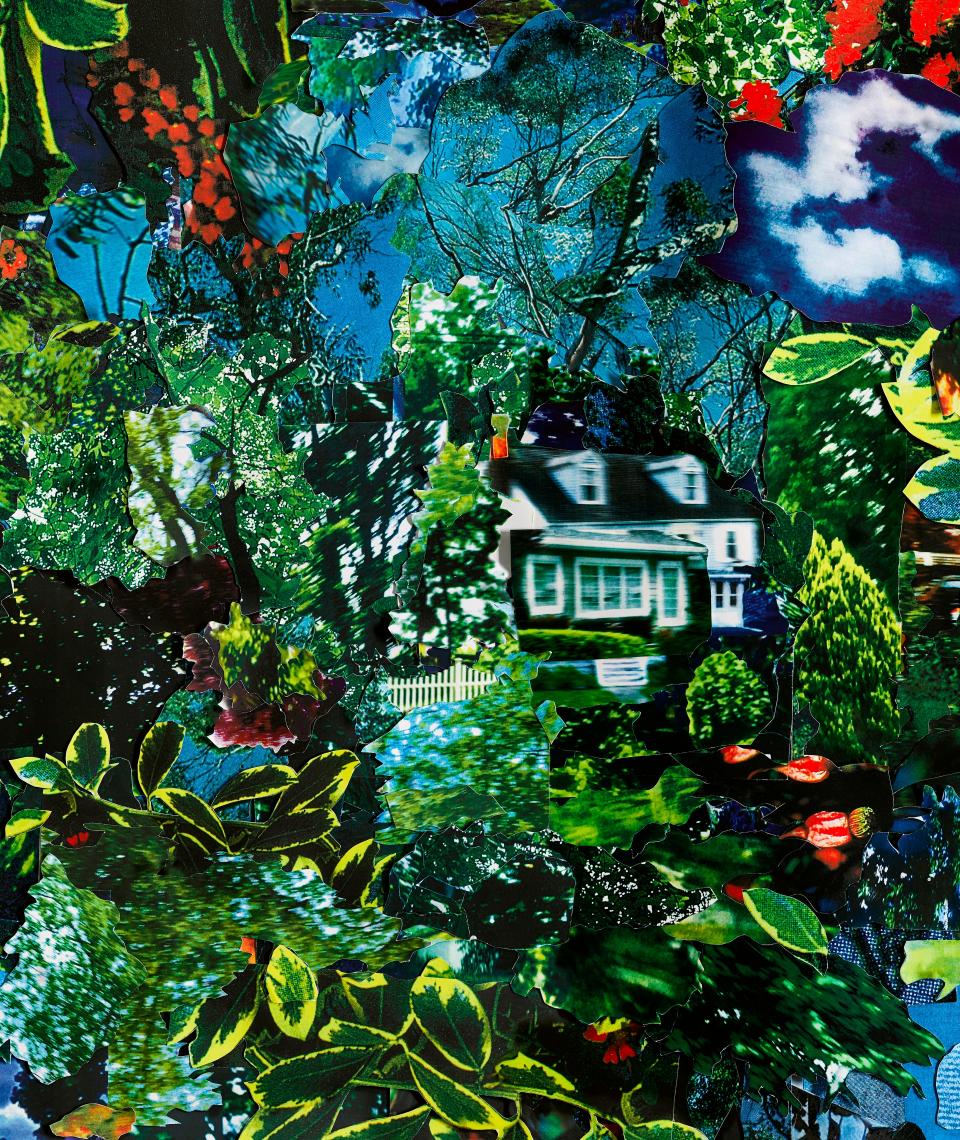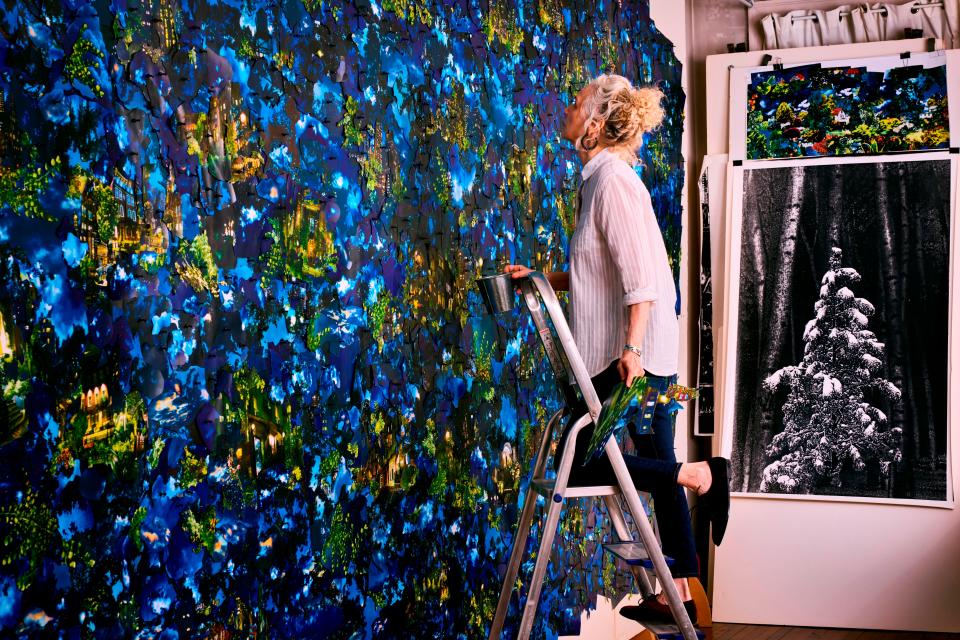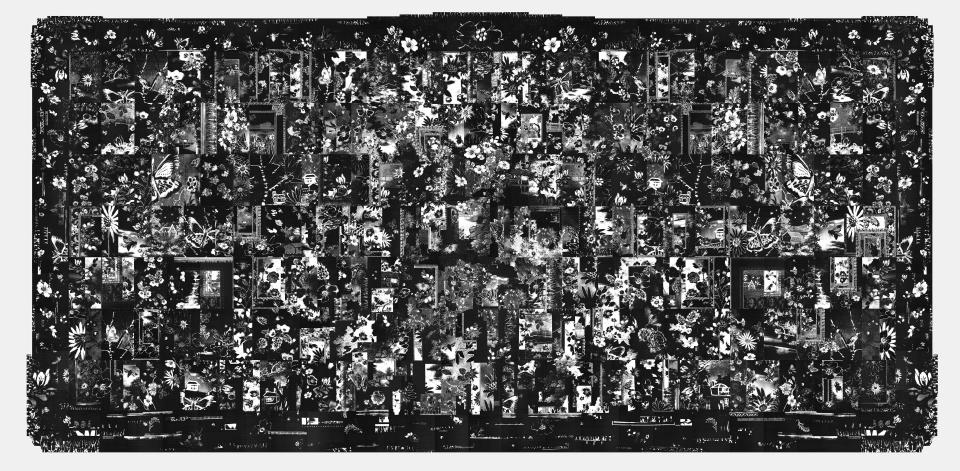Ringling Museum presents Lorna Bieber’s fractured fairy tales in new exhibition
“Lorna Bieber: Natural World” invites you into alternate realms in The Ringling’s latest exhibition. Curator Chris Jones beautifully captures the Eden-like gardens of the artist’s imagination. On closer inspection, Bieber’s natural scenes are comprised of artificial icons. But that’s her style.
In the many worlds of Lorna Bieber’s art, the whole is always greater than the sum of its parts. Her mode and modus is turning trash into treasure. She trawls the ephemeral effluvia of popular culture for banal, cliché images of flora, fauna, tidy houses, and cute landscapes. With high-tech copy machines, high-end printers, and X-Acto knives.
Bieber copies, cuts and collages these fragments together into large-format photographs, which she calls “Murals.” These dense vistas imply both allegorical narratives and a sense of three-dimensional space. “Tapestry” (2015) is a monochromatic riot of butterflies and pretty flowers. (The inkjet image measures a whopping 24.5 x 11'). Ordinary Day (2019) is a jangled vista of happy homes in New England, an inkjet-on-fabric mash-up in shades of forest green and indigo blue. (Its dimensions are 116" x 253").
Arts Newsletter: Sign up to receive the latest news on the Sarasota area arts scene every Monday
Concerts, arts, festivals and more: 75+ fun things to do in June in Sarasota, Manatee and Charlotte counties
Also at The Ringling: Contemporary Native American artists get a first-of-a-kind showcase

“Quiet Night” (2022) is an idyllic glimpse of welcoming doorways in New York City, the antithesis of the “Mean Streets” cliché. (This inkjet idyll measures 228" x 107") Both pieces are stitched together from Bieber’s iPhone photos. Large-scale or small, Bieber’s work has a fairy tale feel. During a walk-through of this exhibition, I asked her to let us in on her world-building secrets. The fabulist was happy to share.
What’s your artistic origin story?
I was a lucky kid. I’ve known I was an artist since I was three or four years old. All my friends and family members reinforced that. I just assumed everybody had that kind of support system. I decided to major in art, and my parents encouraged me. After I went to college, then I met kids whose parents had said, “We're not going to pay for your education if you decide to major in art.” That’s when I realized how lucky I was. But being “lucky” didn’t mean my path as an artist was easy.
How so?
Unlike other artists I’d known, I wasn't constantly drawing and scribbling in notebooks. The blank page always intimidated me. For years that was a major stumbling block to my artistic growth.
How’d you get over that block?
The biggest gift in my life was working in the art department of a major news magazine. They still had a darkroom at the time. And, every week, they’d throw out stacks and stacks of unused photos from the issue they’d just put to bed. Something about them intrigued me, and they allowed me to take some home. They also had a $40,000 copy machine, which was very cutting edge in the early ‘90s, and I used that in a variety of ways to both duplicate and alter the images.
More by Marty Fugate: Art imitates life and vice versa in Selby Gardens’ Tiffany exhibition
‘Shear Madness’ at FST: Audience decides 'whodunnit' and how in comic murder mystery
After the storm: Venice Theatre plans extensive new season while rebuilding from Hurricane Ian damage

And, thanks to this magazine, you now had a treasure trove of original photos and high-resolution copies?
Yes, I did. I took these images home and played around, the way kids do with magazine photos. Except I had the originals! I’d erase eyeballs, add a happy face, or make a black chalk outline around the figures. Then I looked at what I’d done and I liked what I saw. I was amazed at how these simple interventions would powerfully affect the original image and make it mine. In fact, they were more “mine” than any “original” piece I had ever done.
And you realized the artistic potential in this approach?
Exactly! I decided, “This is how I want to work. I’ll work with other people’s images, but only generic images without artistic merit. “
How did that early decision lead to your current artistic practice?
Experimentation and luck. I tried a wide variety of things. I initially collaged, drew on and cropped the individual images. Then I’d edit my work on a table and choose a single image from the stacks of altered images. Later, I decided to pin rows and rows of them on a wall and edit that way. It was a serendipitous gift. I liked that effect of seeing these images together – all the variations and permutations. So instead of selecting down, I decided to put them together and make one large multi-part montage.
A more-is-more approach?
Absolutely!
Once you left the magazine where did you find all the images you play with?
I start by collecting thousands of generic images from magazines, books, catalogs and ad flyers. I’ll narrow them down to 100 or so.
Striking images?
No, if it’s interesting at all, I’m not interested! If an image grabs me, I can’t use it. I like images that have little or no artistic value. I’ve also been working with my own iPhone photos for the last few years, and I have my own copier. I’ll manipulate these various images in a variety of ways – copier, Photoshop, drawing, collage – it’s a very experimental, trial-and-error approach.

And you make the images interesting. That’s your art.
Yes. But it’s collaborative art, in many ways. Early on, I was having my work printed by a commercial lab and it looked awful. After acquiring two of my pieces for the Metropolitan Museum of Art, photography curator Maria Morris Hambourg said, “I think I have a good printer for you.” And she connected me to Chuck Kelton, who’s a renowned master printer. I had only been able to make 11 x 17” pieces, but after working with Chuck, I was able to produce the size I wanted, which was pretty much the size of a door. I was ignorant of any traditional printing rules, but Chuck supported my unconventional approach in the darkroom. He’s supported me, and taught me, and has been wonderfully generous.
Do you start with a specific image in mind? A result you want to see?
No. I might aim for a certain mood, like the sense of revelation when Sleeping Beauty looks out the window in her castle. The fairy tale revelation appeals to me, the sense of bringing another world into our world. That’s the magic feeling I want to evoke. But I don’t start with a definite image in my mind.
So how do you find the magic?
Well, I’m very process-oriented. I start out with lots of little fragments. I’ll try to see what works, how the bits and pieces might become a whole. It’s fun to talk about how I make my work, and critics and curators have said that it is conceptually innovative. But for me it was purely a matter of necessity being the mother of invention. It was a practical workaround to avoid the blank page. I developed this way of working and this visual language in order to enable me to express and arouse emotional feelings. My goal wasn’t to make something new. My desire was to bring forth the images that don’t exist in our world, but reside in the depth of our collective consciousness. What moves me the most is when people look at my work and say, “I know it’s not real, I’ve never seen this before, but it feels deeply familiar.”
‘Lorna Bieber: Natural World’
Runs through Oct. 15 at The Ringling’s Monda Gallery, 5401 Bay Shore Rd., Sarasota; 359-5700; ringling.org
This article originally appeared on Sarasota Herald-Tribune: Q&A with artist Lorna Bieber on new Ringling Museum exhibit

